

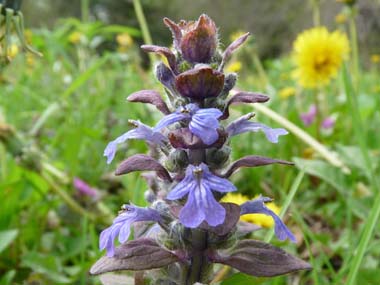
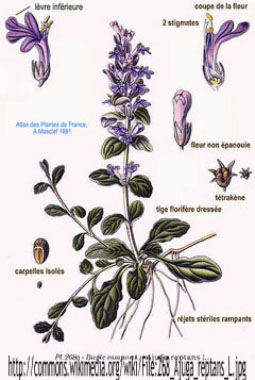
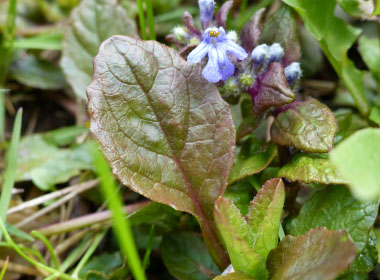

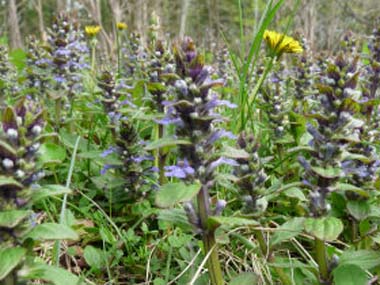

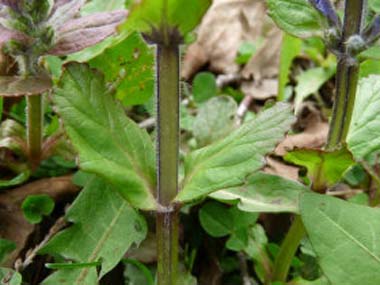
To support our efforts please browse our store (books with health benefits, etc.).
Bugleweed is in the Lamiaceae (mint) family and is native to north-western Africa (Algeria and Tunisia), Europe and western Asia (Iran, northern Turkey, Azerbaijan, Georgia and southern Russia). This is an evergreen perennial that grows at a slow rate. It has a long history of use to help with wounds, and is used in ointments and medicated oils.
Distinguishing Features
Growing in a prostrate mat growth habit, bugleweed is perennial that is also used in gardens as groundcover. It has showy green or multi-colour foliage. It forms colonies of rosettes in damp meadows or woodlands. It produces short spikes of blue flowers and uses stolons (runners) to spread.
Flowers
The flowers are hermaphrodite and are pollinated by bees (although they also attract butterflies and hummingbirds as well). Flowers are deep purplish blue and are in clusters in the axils of the leaves; the calyx has four broad, blunt teeth and the corolla is four-lobed, purplish in colour, with only two fertile stamens. Flowers May to September depending on location.
 Fields
of Nutrition has medicinal benefits and vitamin/mineral content of Bugleweed.
Fields
of Nutrition has medicinal benefits and vitamin/mineral content of Bugleweed.
Leaves
The leaves are opposite; those on the upper part being toothed and lance-shaped, the lower ones wedge-shaped and with entire margins. The leaves are destitute of hairs and gland-dotted beneath. Lower leaves are generally 8cm long and 2cm wide. The dark leaves have an unusual colouration, with a purplish-brown or violet sheen on a dark green ground colour.
Height
They grow anywhere from 5 to 50 cm tall.
Habitat
Bugleweed tends to prefer areas that are slightly shady and damp although it is drought tolerant. It is typically found in damp grassy fields and around the edges of forests. It will grow in all types of soil (acidic, balanced and alkaline). Some people like to grow this as ground cover in their yards. It can be found in many areas across Canada, the U.S., Europe, parts of Asia, Africa, Australia, New Zealand, and South America.
Edible Parts
Young shoots can be eaten in salads or sautéed. Young leaves are also edible; use in salads, teas, casseroles, etc.
Other Name
Carpet Bugle.
Winter Survival Food Handbook

PDF Plant Magazines
Types of Wild Food
Geographic Zones Seasons
Disclaimer
EdibleWildFood.com is informational in nature. While we strive to be 100% accurate, it is solely up to the reader to ensure proper plant identification. Some wild plants are poisonous or can have serious adverse health effects.
We are not health professionals, medical doctors, nor are we nutritionists. It is up to the reader to verify nutritional information and health benefits with qualified professionals for all edible plants listed in this web site. Please click here for more information.
Why Edible Wild Food?
- Food costs are rising
- Free, wild food is readily abundant
- Wild food adds nutrition to your diet
- Wild food can help treat various medical conditions





